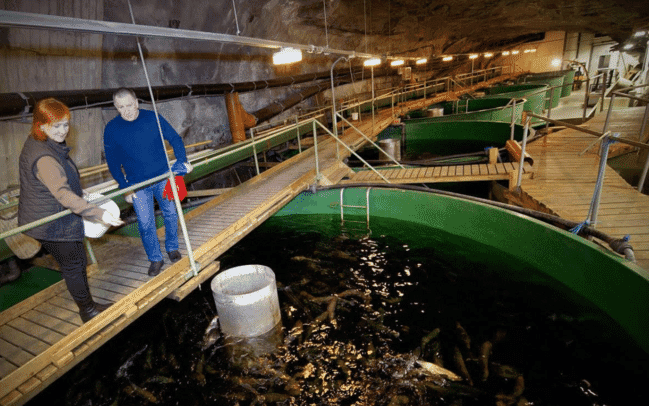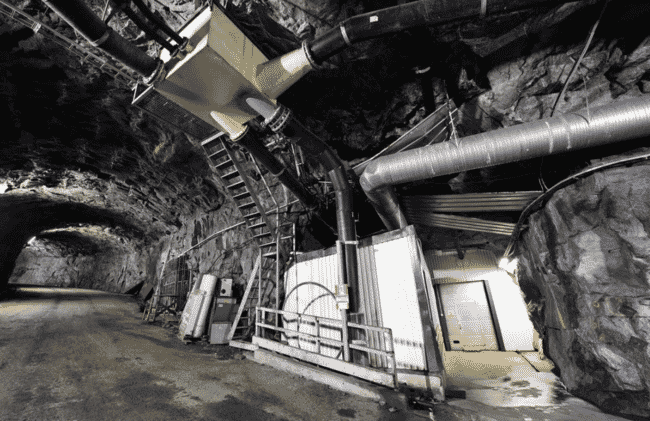
The farm, which produces rainbow trout, is located in the Verkhnetulomsky district of the Murmansk region, close to the Finnish border. It is sited under the Verkhnetulomskaya power station, the most powerful hydroelectric power plant in the region.
The farm is 50 metres under the Verkhnetulomskoe reservoir, on the Kola Peninsula.
Sergei Prudnik, head of the company, commented: "This is the only aquaculture enterprise in the Murmansk region that produces juvenile trout for on-growing and the world’s only [aquaculture farm] located underground”.
The farm was established on the site of a former fish pass which was built during the construction of the Verkhnetulomskaya power station at the beginning of the 1960s, with the aim to allow spawning salmon to pass through it.
“The route for the wild salmon was blocked by the dam, so they built a special elevator for the fish. However, the pass was used by salmon for spawning only once, in 1965,” Prudnik explains.

In 1992 scientists and workers of the station decided to re-develop the pass into a fish farm. According to analysts of the Russian TASS business paper, most of the equipment for its needs was supplied and installed by Atri Enterprises.
The farm consists of two large chambers, the first of which is used as hatchery and is made up of 28 tanks, each with a capacity of 7 cubic metres of water. The annual production capacity is 1.5 million juveniles, although there is the possibility to increase this in years to come.
Valentina Belyaeva, deputy director of the farm, commented: “The plant is currently operated on a full cycle basis, when a whole cycle from the production of eggs to finished stocking material takes six months. For eggs, we need a water temperature of 10°C, for fry no higher than 14°C. One of the main features of our production is that water does not need to be specially heated. Cold water from the reservoir is mixed with warm water from the cooling system of the hydroelectric power plant, which makes ideal conditions for producing juveniles”.
As juveniles grow, they are sorted and put in different tanks. Most of the feed is purchased in Denmark, as Russia does not have its own production. The plant works strictly in accordance with customers’ orders. This year the hatchery aims to produce 1.3 million juveniles, most of which will be supplied to Russian aquaculture producers in the Arkhangelsk, Karelia, and Murmansk regions.
According to representatives of the company, customers usually purchase juveniles at 5-10 grams, before ongrowing them at their own farms.

According to Prudnik, all the production processes at the farm are fully automated and are carried in accordance with all the existing standards for such activities in Russia, which are a subject of regular checks from the Russian Federal Service for Veterinary and Phytosanitary Surveillance (Rosselkhoznadzor).
The production complies with all ecological norms, taking into account the status of Verkhnetulomskoe as one of the cleanest reservoirs in Russia.
In the meantime, the second part of the plant is used for adult trout and broodstock. It’s made up of eight pools, each with a capacity of 42 cubic metres. The water comes directly from the reservoir, without any heating. A female trout can produce up to 6,000 eggs per spawning season. The broodstock are kept for no more than six years.
The annual rate of the renewal of the company’s broodstock is around 25-30 percent, after which rejected fish are incinerated.
During warmer weather, trout become more active and need more feed. During winter time they slow down and, as soon as the water temperature reaches 6-7°C, the fish begin to mature.
According to Belyaeva, while spawning in nature usually takes place in the autumn, the company can regulate these cycles in artificial conditions, raising the temperature sharply prior the spawning period and reducing it during the period of maturation.
Despite the size of the production, the plant employs only five workers, but this number may increase should plans to expand go ahead.


